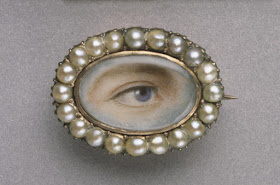The eye miniature was popular for a brief moment in the late 1700s and early 1800s among well-to-do families. These “lover’s eyes”—a term coined by New York–based antique collector Edith Weber—are now archaic reminders of aristocratic England, mentioned fleetingly in old diaries and Charles Dickens’s 1846 novel "Dombey and Son." A “lover’s eye” miniature is a painted miniature of the giver’s eye, presented to a loved one. The notion accompanying this very short-lived fad was that the eye would be recognizable only to the recipient and could, therefore, be worn publicly keeping the lover’s identity a secret.
The miniatures became popular due to a scandalous affair between the Prince of Wales, later crowned King George IV of England, and a widowed commoner named Maria Fitzherbert. Despite disapproval from the court, the two wed in secret, and in 1785 commissioned portraits of their eyes as discreet and intimate tokens of affection. Once their story leaked to the public, however, lover’s eyes became en vogue among the privileged classes.
In the early nineteenth century, eye miniatures evolved into a form of memorial jewelry. Decorated with a tear or depicted as gazing through clouds, it was the ultimate way to remember a dear departed loved one. Eye miniatures with a memorial intention usually also incorporated hairwork. The symbolism of gemstones used to surround the portrait added to the sentiment. Pearls often represented tears. By 1830, the trend itself petered out with the invention of the camera.
To see more eye miniatures, check out the collections at the Philadelphia Museum of Art or the Birmingham Museum of Art.



This is fantastic gift ideas shared by you..
ReplyDeletesend online gifts to india